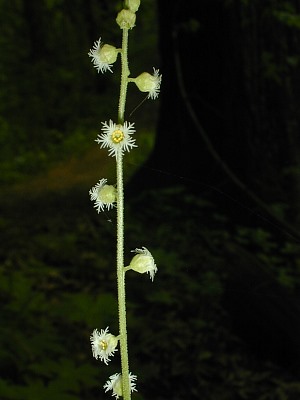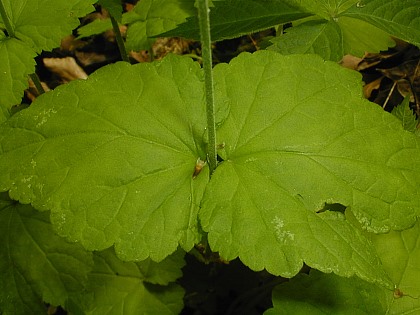Description: This herbaceous perennial plant has an erect flowering stalk about 8-16" tall. Toward the lower middle of this unbranched stalk, there is a single pair of opposite leaves. These leaves are nearly sessile, oval-cordate, coarsely crenate or dentate along the margins, and often shallowly 3-lobed; they are about 2" long and 1¼" across. The flowering stalk is slender, light green, and pubescent. At the base of the plant, there are basal leaves on long petioles. Except for their petioles, they resemble the pair of opposite leaves. The inflorescence is an erect raceme; each flower is widely spaced from the others along the stalk. The pedicels of these flowers are quite short. Each white flower is a less than than ¼" across; it consists of 5 white petals, 10 yellow stamens, a pair of styles, a greenish white calyx with 5 short lobes, and a single-celled ovary. The petals are deeply pinnatifid, which provides them with a fringed appearance. The blooming period occurs from mid- to late spring. After the blooming period, each flower is replaced by an open capsule that contains many small seeds. These seeds are distributed by raindrop logistics (raindrops striking the capsule cause it to bend and fling some of its seeds). The root system can produce vegetative colonies from rhizomes.

Cultivation:
The preference is dappled sunlight during the spring, otherwise shade
is tolerated. Bishop's Cap is usually found in mesic to dry areas of
woodlands where the soil contains abundant organic matter, often where
there is rocky ground. Most growth and development occurs during the
spring when the soil is normally moist.
Range & Habitat:
The native Bishop's Cap occurs occasionally in northern, east-central,
west-central, and hilly areas of southern Illinois; in many central and
south-central areas of the state, it appears to be absent (see Distribution
Map). Habitats include upland woodlands, wooded slopes, rocky
bluffs, and shady ravines. The substrate of the rocky woodlands where
this species occurs can consist of either limestone or sandstone. This
species is usually found in high quality woodlands.

Faunal
Associations:
The flowers are pollinated by Syrphid flies and small short-tongued
bees (including Halictid bees and Little Carpenter bees). These insects
suck nectar from the flowers; the Syrphid flies also feed on the
pollen, while the short-tongued bees collect pollen for their larvae.
Aside from these insect visitors, little appears to be known about
floral-faunal relationships for this species.
Photographic Location:
A rocky wooded slope at Shades State Park in west-central Indiana.
Comments:
The small delicate flowers are very attractive and fairy-like. Bishop's
Cap can be distinguished from other similar wildflowers by the fringed
appearance of its flower petals and the pair of nearly sessile leaves
on its flowering stalk.